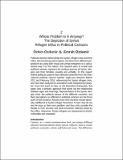Files in this item
Whose problem is it anyway? The depiction of Syrian refugee influx in political cartoons
Item metadata
| dc.contributor.author | Özdemir, Özlem | |
| dc.contributor.author | Özdemir, Emrah | |
| dc.date.accessioned | 2017-06-07T13:15:56Z | |
| dc.date.available | 2017-06-07T13:15:56Z | |
| dc.date.issued | 2017-01-21 | |
| dc.identifier.citation | Özdemir, Ö. and Özdemir, E. (2017). Whose problem is it anyway? The depiction of Syrian refugee influx in political cartoons. Syria Studies, 9(1), 33-63. | en_US |
| dc.identifier.issn | 2056-3175 | en_US |
| dc.identifier.uri | https://ojs.st-andrews.ac.uk/index.php/syria/article/view/1480 | en_US |
| dc.identifier.uri | https://hdl.handle.net/10023/10930 | |
| dc.description.abstract | Political cartoons demonstrate the Syrian refugee crisis and their influx into bordering and European countries from different perspectives by using both visual and verbal metaphors in a caricaturised way. For this reason, this research aims to reveal how political cartoons represent the perilous journey of Syrian refugees and their families visually and verbally. In this regard, twelve political cartoons were selected randomly from the international political cartoon website cagle.com between March 2011 and February 2016, referencing the Syrian refugee crisis, and have been analysed in accordance with metaphorical analysis. From this point of view, as the theoretical framework, this paper uses a semiotic approach that points out the relationship between signs and meanings. Representation of the Syrian refugee crisis, the political stances of the different countries, and their perceptions as reflected in political cartoons are the focus point of this research. Results show that countries remain generally indifferent to Syrian refugee movement. In fact, they do not see the issue as their own problem, and they only consider the threats to their security and socio-economic interests posed by the influx. Moreover, Syrian refugees are represented as lonely, vulnerable and unwanted. | en_US |
| dc.language.iso | en | en_US |
| dc.publisher | Centre for Syrian Studies, School of International Relations, University of St Andrews | en_US |
| dc.relation.ispartof | Syria Studies | en_US |
| dc.rights | Attribution 4.0 International | en_US |
| dc.rights.uri | http://creativecommons.org/licenses/by/4.0/ | * |
| dc.subject | Contemporary Syria | en_US |
| dc.subject | Politics | en_US |
| dc.subject | Political economy | en_US |
| dc.subject | Sieges | en_US |
| dc.subject | Political Cartoons | en_US |
| dc.subject | Baath Ideology | en_US |
| dc.subject | Husari | en_US |
| dc.subject | Aflaq | en_US |
| dc.subject | Middle East | en_US |
| dc.subject.lcc | DS92.S9 | en_US |
| dc.subject.lcsh | Syria | en_US |
| dc.title | Whose problem is it anyway? The depiction of Syrian refugee influx in political cartoons | en_US |
| dc.type | Journal article | en_US |
| dc.description.version | https://doi.org/Publisher PDF | en_US |
| dc.publicationstatus | Published | en_US |
| dc.status | Peer reviewed | en_US |
The following licence files are associated with this item:
This item appears in the following Collection(s)
Except where otherwise noted within the work, this item's licence for re-use is described as Attribution 4.0 International
Items in the St Andrews Research Repository are protected by copyright, with all rights reserved, unless otherwise indicated.


